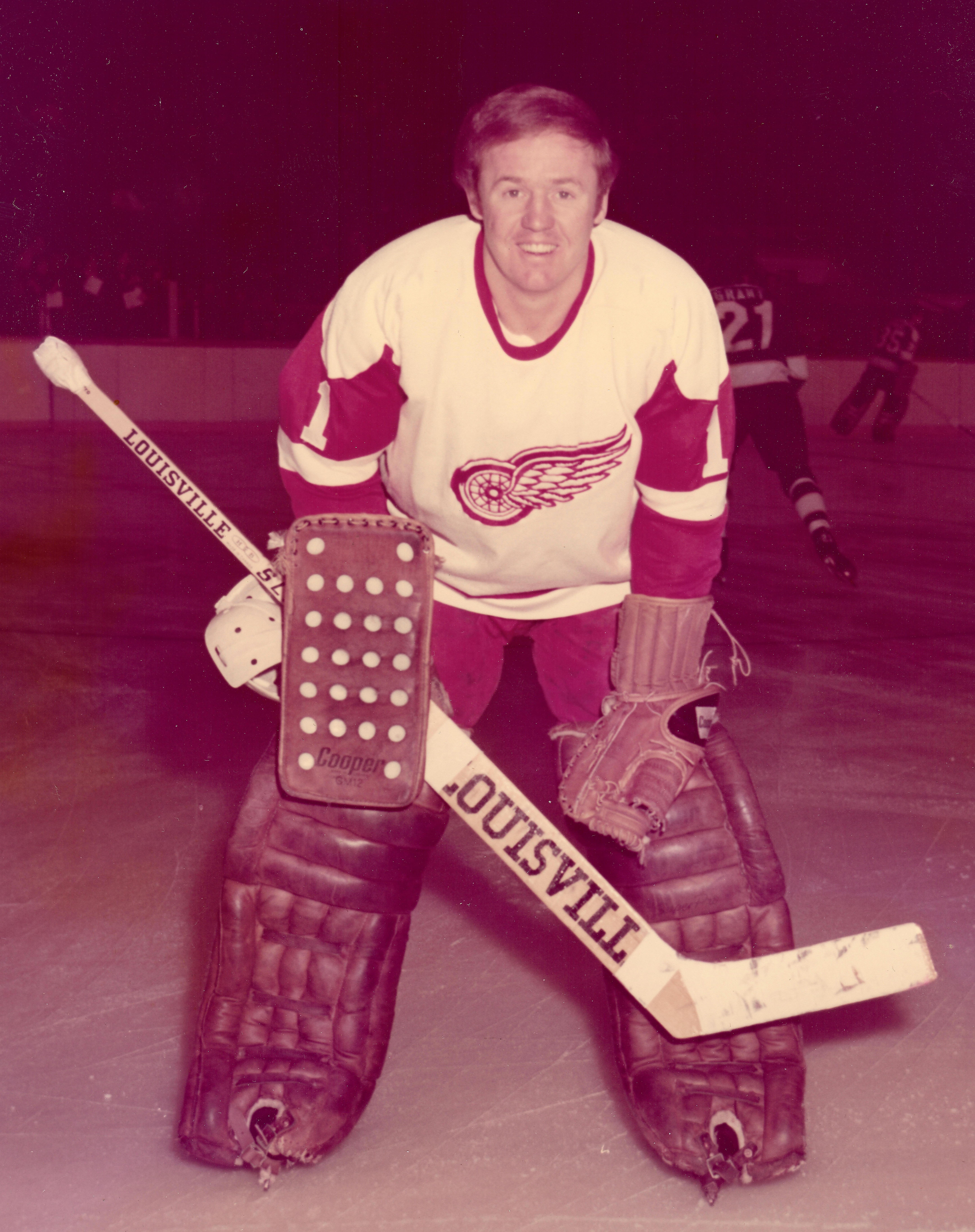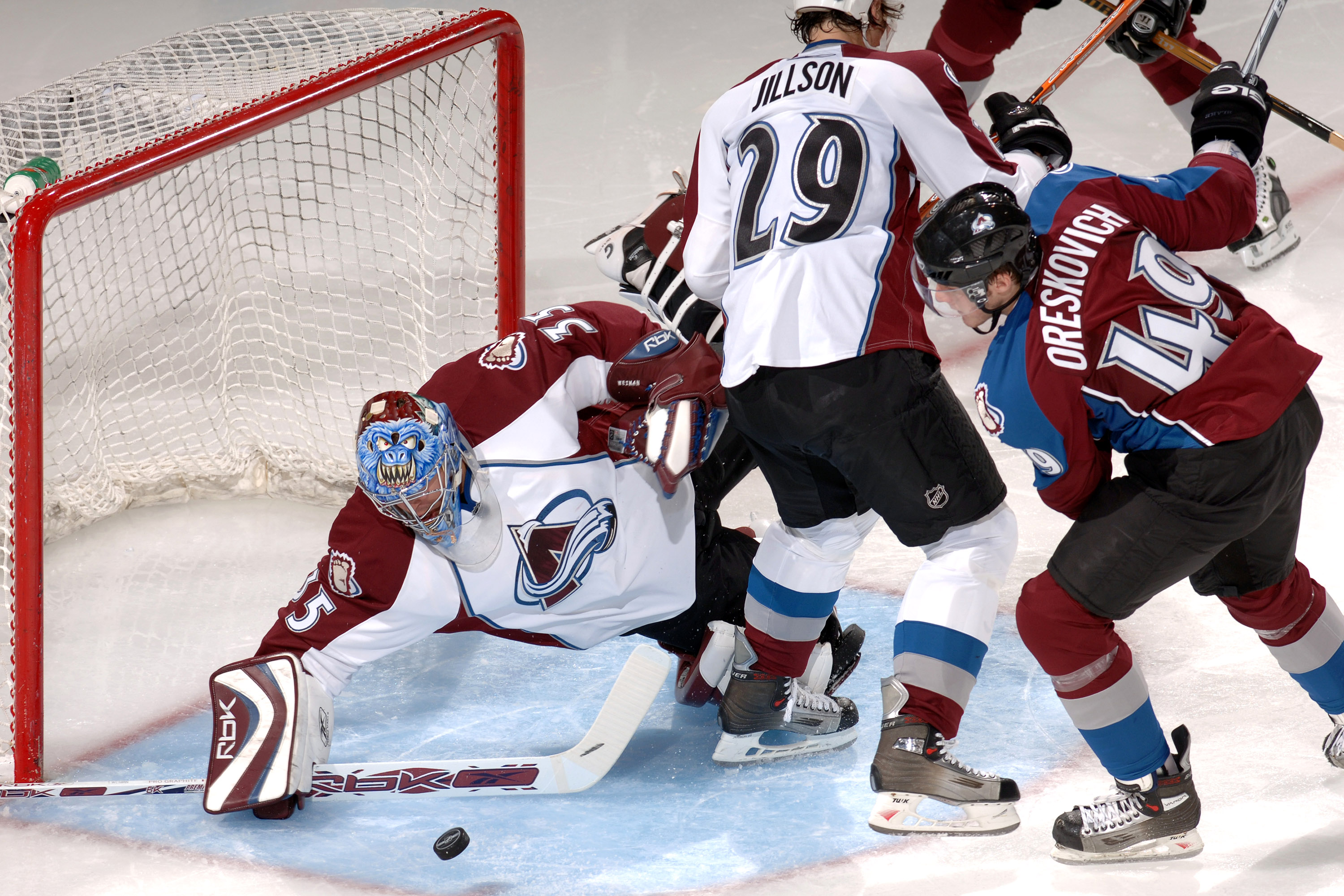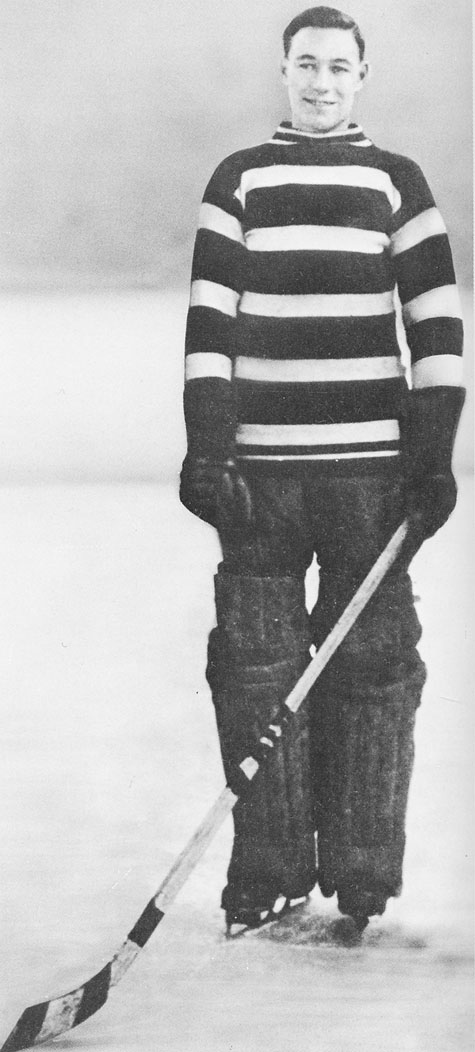|
Bill McKenzie (ice Hockey)
William Ian McKenzie (born March 12, 1949) is a Canadian former professional ice hockey goaltender who played for the Detroit Red Wings, Kansas City Scouts, and Colorado Rockies in the National Hockey League (NHL) between 1973 and 1980. He also played in various minor leagues, primarily the American Hockey League and Central Hockey League. Early life McKenzie was born in St. Thomas, Ontario, but his family later moved to Riverside, Ontario. He attended Riverside Secondary School from 1964 to 1968, where he competed in football, track, and hockey. Career Prior to turning professional, McKenzie played for Ohio State University (1968–72), where he helped the team win the inaugural CCHA Tournament Championship in 1972. He was later inducted into the Ohio State University Sports Hall of Fame. Upon retirement from professional hockey, he worked in sales, but continued his involvement with the sport as a volunteer assistant coach for the Ohio State Buckeyes men's ice hockey ... [...More Info...] [...Related Items...] OR: [Wikipedia] [Google] [Baidu] |
Goaltender
In ice hockey, the goaltender (commonly referred to as the goalie) is the player responsible for preventing the hockey puck from entering their team's net, thus preventing the opposing team from scoring. The goaltender mostly plays in or near the area in front of the net called the ''Ice hockey rink#Crease, goal crease'' (often referred to simply as '' the crease''). Goaltenders tend to stay at or beyond the top of the crease to cut down on the angle of shots. In the modern age of goaltending there are two common styles, butterfly and hybrid (hybrid is a mix of the traditional stand-up style and butterfly technique). Because of the power of shots, the goaltender wears special equipment to protect the body from direct impact. Goaltenders are one of the most important players on the ice, as their performance may greatly impact the outcome or score of the game. One-on-one situations, such as breakaways and shootouts, have the tendency to showcase a goaltender's pure skill, or lack ... [...More Info...] [...Related Items...] OR: [Wikipedia] [Google] [Baidu] |
NCAA Division I Men's Ice Hockey Tournament
The annual NCAA Division I Men's Ice Hockey Tournament is a college ice hockey tournament held in the United States by the National Collegiate Athletic Association (NCAA) to determine the top men's team in Division I. Like other Division I championships, it is the highest level of NCAA men's hockey competition. This tournament is somewhat unique among NCAA sports as many schools which otherwise compete in Division II or Division III compete in Division I for hockey. Since 1999, the semi-finals and championship game of the tournament have been branded as the "Frozen Four"—a reference to the NCAA's long-time branding of its basketball semi-finals as the " Final Four". History The NCAA Men's Division I Ice Hockey Championship is a single elimination competition that has determined the collegiate national champion since the inaugural 1948 NCAA Men's Division I Ice Hockey Tournament. The tournament features 16 teams representing all six Division I conferences in the nation. The ... [...More Info...] [...Related Items...] OR: [Wikipedia] [Google] [Baidu] |
Port Huron Wings
The Port Huron Flags were a minor league professional ice hockey team located in Port Huron, Michigan. The Flags competed in the International Hockey League between 1962 and 1981. For three of those seasons from 1971 to 1974, Port Huron was a farm team of the Detroit Red Wings, and were known as the Port Huron Wings. Port Huron won the International Hockey League playoff title, known as the Turner Cup The Turner Cup was the championship trophy of the International Hockey League from 1945 to 2001 and the renamed United Hockey League from 2007 to 2010. The Cup was named for Joe Turner, a goaltender from Windsor, Ontario. Turner became professi ..., in 1966, 1971, and 1972. Season-by-season results * Port Huron Flags, 1962–1971 and 1974–1981 * Port Huron Wings, 1971–1974 References Defunct ice hockey teams in the United States Professional ice hockey teams in Michigan Port Huron, Michigan Ice hockey clubs established in 1962 Sports clubs disestablished in ... [...More Info...] [...Related Items...] OR: [Wikipedia] [Google] [Baidu] |
1972–73 IHL Season
The 1972–73 IHL season was the 28th season of the International Hockey League, a North American minor professional league. Nine teams participated in the regular season, and the Fort Wayne Komets won the Turner Cup. Regular season Turner Cup Playoffs External links Season 1972/73on hockeydb.com {{DEFAULTSORT:1972-73 IHL season IHL International Hockey League (1945–2001) seasons ... [...More Info...] [...Related Items...] OR: [Wikipedia] [Google] [Baidu] |
Central Collegiate Hockey Association
The Central Collegiate Hockey Association (CCHA) is a college athletic conference that participates in the NCAA's Division I as a hockey-only conference. The current CCHA began play in the 2021–22 season; a previous incarnation, which the current CCHA recognizes as part of its history, existed from 1971 to 2013. Half of its members are located in the state of Michigan, with additional members in Minnesota and Ohio. It has also had teams located in Alaska, Illinois, Indiana, Missouri and Nebraska over the course of its existence. The CCHA was disbanded after the 2012–13 season as the result of a conference realignment stemming from the Big Ten Conference (of which three CCHA schools; Michigan, Michigan State, and Ohio State, were primary members) choosing to sponsor Division I ice hockey beginning in the 2013–14 season. The remaining CCHA members received invitations to other conferences, such as the newly formed National Collegiate Hockey Conference (NCHC), Hockey East, an ... [...More Info...] [...Related Items...] OR: [Wikipedia] [Google] [Baidu] |
1970–71 NCAA University Division Men's Ice Hockey Season
The 1970–71 NCAA University Division men's ice hockey season began in November 1970 and concluded with the 1971 NCAA University Division Men's Ice Hockey Tournament's championship game on March 20, 1971 at the Onondaga War Memorial in Syracuse, New York. This was the 24th season in which an NCAA ice hockey championship was held and is the 77th year overall where an NCAA school fielded a team. Saint Louis begins to sponsor their ice hockey program as an independent. Season Outlook Pre-season poll The top 10 teams were compiled by Gary Bender, sports director of WKOW television and radio stations in Madison, Wisconsin. Regular season Season tournaments Standings Final regular season poll The final top 10 teams were compiled before the conference tournaments. 1971 NCAA Tournament Note: * denotes overtime period(s) Player stats Scoring leaders The following players led the league in points at the conclusion of the season. ''GP = Games played; G = Goals; A = Assi ... [...More Info...] [...Related Items...] OR: [Wikipedia] [Google] [Baidu] |
NCAA Division I
NCAA Division I (D-I) is the highest level of College athletics, intercollegiate athletics sanctioned by the National Collegiate Athletic Association (NCAA) in the United States, which accepts players globally. D-I schools include the major collegiate athletic powers, with large budgets, more elaborate facilities and more athletic scholarships than Divisions II and III as well as many smaller schools committed to the highest level of intercollegiate competition. This level was previously called the University Division of the NCAA, in contrast to the lower-level College Division; these terms were replaced with Roman numerals, numeric divisions in 1973. The University Division was renamed Division I, while the College Division was split in two; the College Division members that offered scholarships or wanted to compete against those who did became NCAA Division II, Division II, while those who did not want to offer scholarships became NCAA Division III, Division III. For colle ... [...More Info...] [...Related Items...] OR: [Wikipedia] [Google] [Baidu] |
1969–70 NCAA University Division Men's Ice Hockey Season
The 1969–70 NCAA University Division men's ice hockey season began in November 1969 and concluded with the 1970 NCAA University Division Men's Ice Hockey Tournament's championship game on March 21, 1970, at the Olympic Arena in Lake Placid, New York. This was the 23rd season in which an NCAA ice hockey championship was held and is the 76th year overall where an NCAA school fielded a team. In 1969 the NCAA changed their bylaws to permit freshman to play on the Varsity team. Beginning with this season universities were permitted to not only have first-year students play for their teams but to also have said players earn letters for four seasons rather than the previous limit of three. As a consequence the WCHA offered both a Sophomore-of-the-Year and Freshman-of-the-Year awards with the previous being formally retired following the campaign. Cornell finished the 1969–70 season with an undefeated record of 29–0, only the second flawless campaign in the modern history of Divis ... [...More Info...] [...Related Items...] OR: [Wikipedia] [Google] [Baidu] |
Save Percentage
Save percentage (often known by such symbols as SV%, SVS%, SVP, PCT) is a statistic in various goal-scoring sports that track saves as a statistic. In ice hockey and lacrosse, it is a statistic that represents the percentage of shots on goal a goaltender stops. It is calculated by dividing the number of saves by the total number of shots on goal. Although the statistic is called a "percentage", it is often given as a decimal, in the same way as a batting average in baseball. Thus, .933 means a goaltender saved 93.3 percent of all shots they faced. In international ice hockey, a save percentage is expressed as a true percentage, such as 90%. National Hockey League (NHL) goaltenders typically have a save percentage above .900, and National Lacrosse League (NLL) goaltenders typically have a save percentage above .750. See also *Goals against average Goals against average (GAA) also known as "average goals against" or "AGA" is a statistic used in field hockey, ice hockey, la ... [...More Info...] [...Related Items...] OR: [Wikipedia] [Google] [Baidu] |
Goals Against Average
Goals against average (GAA) also known as "average goals against" or "AGA" is a statistic used in field hockey, ice hockey, lacrosse, soccer, and water polo that is the mean of goals allowed per game by a goaltender or goalkeeper (depending on sport). GAA is analogous to a baseball pitcher's earned run average (ERA). In Japanese, the same translation (防御率) is used for both GAA and ERA, because of this. For ice hockey, the goals against average statistic is the number of goals a goaltender allows per 60 minutes of playing time. It is calculated by taking the number of goals against, multiply that by 60 (minutes) and then dividing by the number of minutes played. The modification is used by the NHL since 1965 and the IIHF since 1990. When calculating GAA, overtime goals and time on ice are included, whereas empty net and shootout goals are not. It is typically given to two decimal places. The top goaltenders in the National Hockey League have a GAA of about 1.85-2.10, alth ... [...More Info...] [...Related Items...] OR: [Wikipedia] [Google] [Baidu] |
Shutout
In team sports, a shutout ( US) or clean sheet ( UK) is a game in which one team prevents the other from scoring any points. While possible in most major sports, they are highly improbable in some sports, such as basketball. Shutouts are usually seen as a result of effective defensive play even though a weak opposing offense may be as much to blame. Some sports credit individual players, particularly goalkeepers and starting pitchers, with shutouts and keep track of them as statistics; others do not. American football A shutout in American football is uncommon but not exceptionally rare. Keeping an opponent scoreless in American football requires a team's defense to be able to consistently shut down both pass and run offenses over the course of a game. The difficulty of completing a shutout is compounded by the many ways a team can score in the game. For example, teams can attempt field goals, which have a high rate of success. The range of NFL caliber kickers makes it possible ... [...More Info...] [...Related Items...] OR: [Wikipedia] [Google] [Baidu] |


